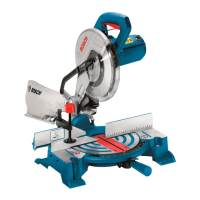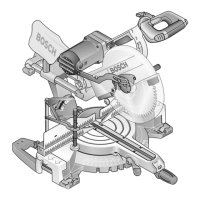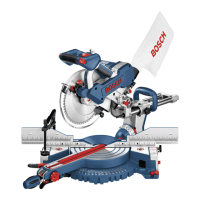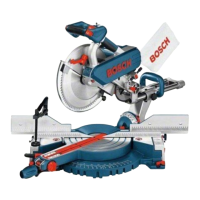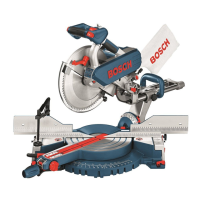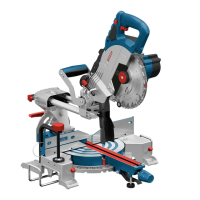16 | English
After sawing the bevel angles, slide the adjustable fence
(17) back again (loosen the wing bolt (21); slide the fence
(17) all the way in; retighten the wing bolt).
Clamping the workpiece (see figure H)
To ensure maximum safety while working, the workpiece
must always be firmly clamped.
Do not saw workpieces that are too small to clamp firmly.
– Press the workpiece firmly against the fences (6) and
(17).
– Insert the supplied screw clamp (18) into one of the cor-
responding holes (8).
– Loosen the wing bolt (43) and adjust the screw clamp to
the workpiece. Tighten the wing bolt again.
– Tighten the threaded rod (44) to fix the workpiece in
place.
Releasing the workpiece
– To loosen the screw clamp, turn the threaded rod (44)
anticlockwise.
Setting mitre and bevel angles
u Pull the plug out of the socket before carrying out any
work on the power tool.
To ensure precise cuts, the basic settings of the power tool
must be checked and adjusted as necessary after intensive
use.
Experience and suitable special tools are required for this.
A Bosch after-sales service point will handle this work
quickly and reliably.
u Always tighten the locking knob (10) firmly before
sawing. Otherwise the saw blade can become wedged in
the workpiece.
Setting mitre angles (see figure I)
The mitre angle can be set between 47° (left side) and 52°
(right side).
– Loosen the locking knob (10) if it is tightened.
– Push the lever (11), turn the saw table (7) left or right by
the locking knob and set the required mitre angle using
the angle indicator (12).
– Retighten the locking knob (10).
For quick and precise setting of commonly used mitre
angles, detents (45) are provided on the saw table:
Left Right
0°
45°; 30°; 22.5°; 15° 15°; 22.5°; 30°; 45°
– Loosen the locking knob (10) if it is tightened.
– Push the lever (11) and turn the saw table (7) left or right
to the required detent.
– Release the lever again. The lever must be felt to engage
in the detent.
– Retighten the locking knob (10).
Setting bevel angles (see figure J)
The bevel angle can be set between 0° and 45°.
– Loosen the clamping handle (26).
– Use the handle (3) to swivel the tool arm until the angle
indicator (31) shows the required bevel angle.
– Hold the tool arm in this position and retighten the clamp-
ing handle (26).
To set the standard angles of 0° and 45° quickly and ac-
curately, stop screws are provided ex-works ((33) and
(23)).
– Loosen the clamping handle (26).
– Swivel the tool arm by the handle (3) all the way to the
right (0°) or all the way to the left (45°).
– Retighten the clamping handle (26).
Start-up
u Pay attention to the mains voltage. The voltage of the
power source must match the voltage specified on the
rating plate of the power tool. Power tools marked
with 230V can also be operated with 220V.
u Products that are only sold in AUS and NZ: Use a resid-
ual current device (RCD) with a nominal residual current
of 30 mA or less.
Switching on (see figure K)
– To start the tool, press the on/off switch (4) and keep it
pressed.
Note: For safety reasons, the on/off switch (4) cannot be
locked; it must remain pressed during the entire operation.
The tool arm can only be guided downwards by pushing the
lever (2).
– For sawing, the lever (2) must therefore be pushed while
the on/off switch (4) is pressed.
Switching off
– To switch off, release the on/off switch (4).
Practical advice
General sawing instructions
u Always tighten the locking knob (10) and the clamp-
ing handle (26) firmly before sawing. Otherwise the
saw blade can become wedged in the workpiece.
u For all cuts, it must first be ensured that the saw blade
at no time can come in contact with the fence, screw
clamps or other machine parts. Remove any mounted
auxiliary stops or adjust them accordingly.
Protect the saw blade against impact and shock. Do not sub-
ject the saw blade to lateral pressure.
Do not saw warped/bent workpieces. The workpiece must
always have a straight edge to face against the fence.
The free end of long and heavy workpieces must have some-
thing placed underneath it or be supported.
Make sure that the retracting blade guard operates properly
and that it can move freely. The retracting blade guard must
open when the tool arm is guided downward. When the tool
arm is guided upward, the retracting blade guard must close
again over the saw blade and lock in the uppermost position
of the tool arm.
1 609 92A 4YM | (15.05.2019) Bosch Power Tools
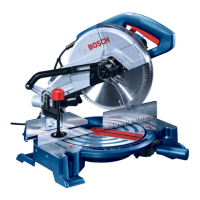
